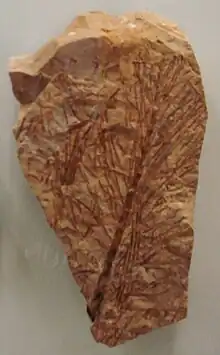Neocalamites
Neocalamites is an extinct genus of Sphenophytes. Neocalamites, thrived during the Permian and Triassic, and occurs on localities from both hemispheres.
| Neocalamites Temporal range: | |
|---|---|
 | |
| Neocalamites merianii | |
| Scientific classification | |
| Kingdom: | |
| Division: | |
| Class: | |
| Order: | |
| Family: | Neocalamitaceae |
| Genus: | Neocalamites |
| Species | |
| |
Description
Sizes ranged from few centimetres to two meters tall and the free leaves occurred at the nodes of the aerial stems. It is supposed that they produced secondary tissues as Calamites, but had bractless cones similar to Equisetum.[1] There are indications that this plant lived in humid places along rivers and shores of lakes.
Location of sites
References
- Elgorriaga, A.; Escapa, I.H.; Rothwell, G.W.; Tomescu, A.M.F.; Cúneo, N.R. (2018). "Origin of Equisetum: Evolution of horsetails (Equisetales) within the major euphyllophyte clade Sphenopsida". American Journal of Botany. 105 (8): 1286–1303. doi:10.1002/ajb2.1125. PMID 30025163.
- Passo das Tropas, Santa Maria, RS. Marco bioestratigráfico triássico na evolução paleoflorística do Gondwana na Bacia do Paraná
This article is issued from Wikipedia. The text is licensed under Creative Commons - Attribution - Sharealike. Additional terms may apply for the media files.